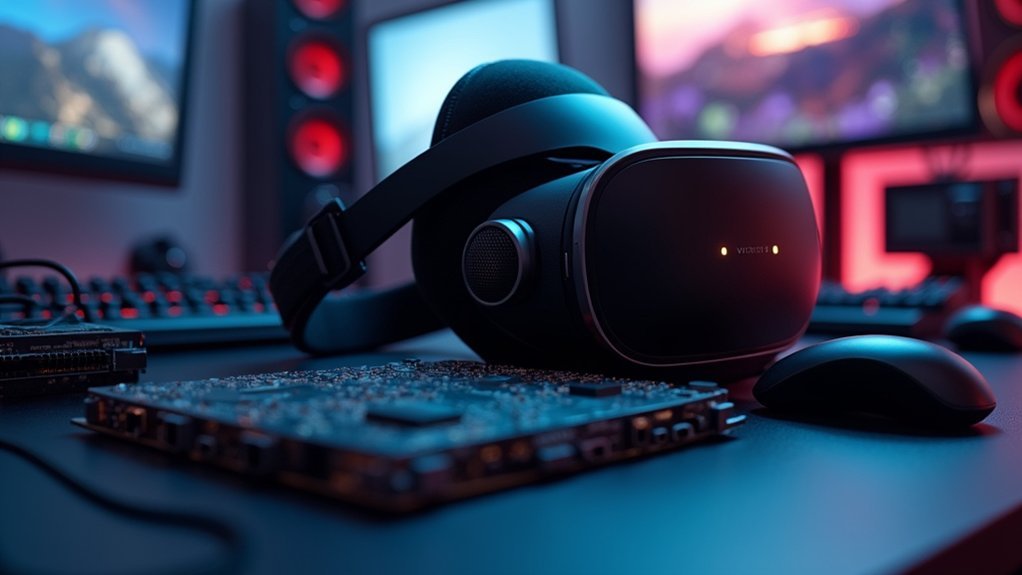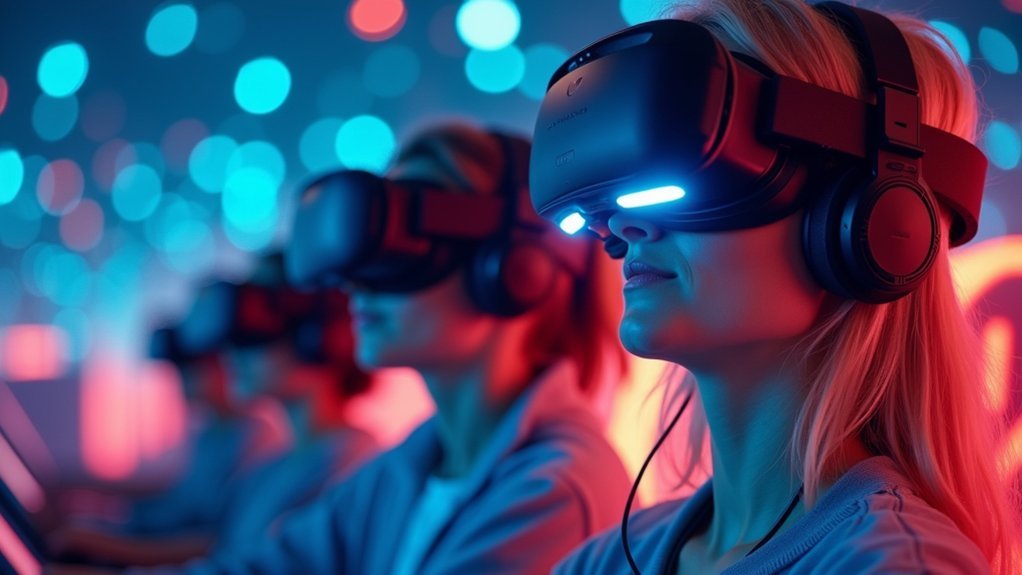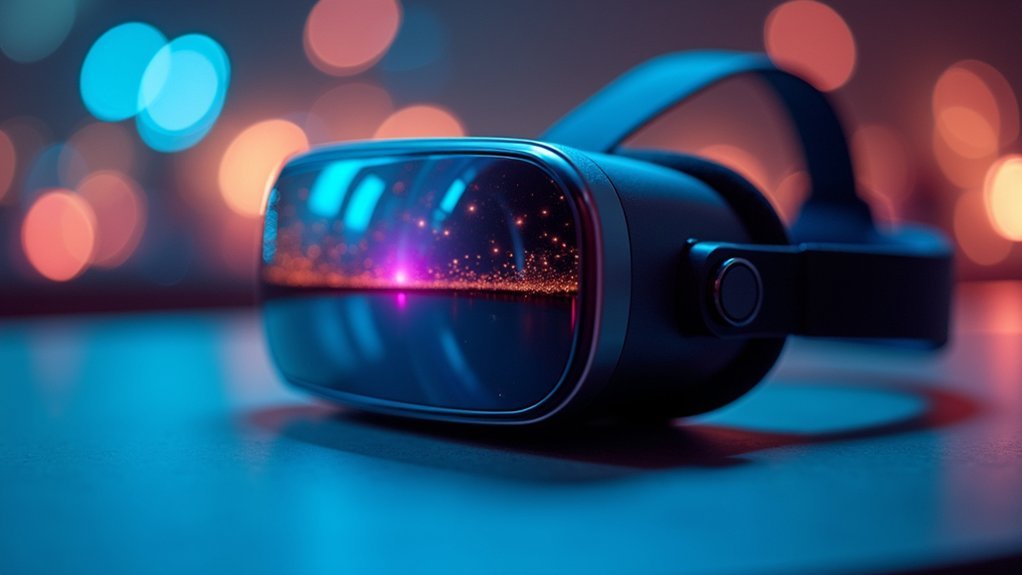You’ll achieve ideal VR immersion by keeping motion-to-photon latency under 20 milliseconds, the critical threshold that prevents cybersickness and maintains comfort. Your VR system’s GPU performance, display refresh rates, and tracking sensor precision directly impact this latency, while network delays in multiplayer environments can disrupt the experience. You can reduce latency through asynchronous reprojection, high-frequency sensors, proper IPD calibration, and choosing nearby servers. Advanced techniques and hardware optimizations will further enhance your virtual reality performance.
Understanding Motion-to-Photon Latency in Virtual Reality

When you move your head in virtual reality, motion-to-photon latency determines how quickly that movement translates into updated visuals on your headset’s display.
This delay represents the complete journey from your physical motion through tracking systems to the final pixel changes you see. Motion-to-photon latency directly affects your immersive experience – high latency breaks the illusion of presence and can trigger motion sickness symptoms like dizziness and nausea.
To maintain comfort and realism, you need latency below 20 milliseconds. Beyond this threshold, your brain detects the mismatch between expected and actual visual feedback.
Modern VR systems achieve low latency through advanced tracking systems, high-refresh-rate displays, and optimized rendering pipelines that prioritize speed without sacrificing visual quality.
The 20 Millisecond Threshold for Optimal VR Performance
Although VR technology has advanced dramatically, your comfort hinges on achieving one critical benchmark: keeping motion-to-photon latency under 20 milliseconds. Beyond this threshold, you’ll experience discomfort and motion sickness as your brain detects mismatches between your movements and visual feedback.
Low latency prevents cybersickness symptoms while maintaining immersion in virtual environments. High refresh rates combined with sub-20-millisecond response times dramatically enhance your VR experience. You’ll notice smoother visuals and more natural interactions when systems maintain these standards.
This becomes especially important for precise interactions in training simulations and competitive gaming, where split-second timing matters. Achieving this 20-millisecond target requires optimized hardware and software working together.
When developers prioritize this threshold, you’ll enjoy seamless virtual experiences that feel natural and responsive to your every movement.
Hardware Components That Impact VR Latency

Your VR headset’s hardware directly determines how quickly it can process and display information, making component selection critical for achieving that sub-20ms latency target.
The three most influential hardware elements—your GPU’s rendering capabilities, display refresh rates, and tracking sensor accuracy—work together to either minimize or amplify latency throughout the entire VR pipeline.
Understanding how each component contributes to overall system responsiveness will help you identify potential bottlenecks that could be sabotaging your immersive experience.
GPU Rendering Performance
Since the GPU serves as the primary engine for rendering VR content, its performance directly determines how quickly frames can be generated and displayed to your headset.
GPU rendering performance must target 90Hz or higher frame rates because low latency is vital for preventing motion sickness and maintaining immersion. Your graphics card’s processing power handles complex vertex calculations, shading operations, and pixel rendering while managing high resolution textures efficiently.
Modern GPUs reduce motion-to-photon latency through optimized rendering pipelines and technologies like asynchronous time warp, which predicts your head movements to render frames accordingly.
Memory bandwidth plays a significant role in handling demanding VR scenes without stuttering. You’ll need sufficient computational power to process complex graphics while maintaining consistent frame delivery for smooth virtual experiences.
Display Refresh Rates
While GPU performance handles frame generation, your VR headset’s display refresh rate determines how frequently those frames actually reach your eyes.
Display refresh rates greatly impact latency, with 90Hz or higher providing the smoothest visuals. At 90Hz, your display updates every 11.1 milliseconds, keeping motion-to-photon latency below the critical 20-millisecond threshold that prevents cybersickness.
Lower refresh rates create visual artifacts and break immersion by increasing perceived delay between your movements and visual feedback.
Modern VR headsets use OLED or fast-switching LCD technologies to achieve these high refresh rates with minimal response times. You’ll notice that higher refresh rates directly improve head tracking accuracy, ensuring your movements translate seamlessly into the virtual world for a truly immersive experience.
Tracking Sensor Precision
Beyond display technology, tracking sensor precision forms the foundation of low-latency VR experiences by detecting even the smallest head movements with remarkable accuracy.
Your tracking sensors, including accelerometers and gyroscopes, must operate at 90Hz or higher to minimize delays between movement and visual response. Advanced optical tracking systems provide real-time feedback that markedly reduces motion-to-photon latency.
However, you’ll need proper sensor calibration, particularly interpupillary distance settings, since misalignment causes up to 40% of cybersickness cases. Intelligent motion tracking systems enhance precision through predictive algorithms, anticipating your next movement before it occurs.
When your tracking sensors deliver precise data rapidly, you’ll experience seamless VR immersion where your natural head movements translate instantly into corresponding visual updates.
Network Latency Challenges in Multiplayer VR Environments

When you’re playing multiplayer VR games, data transmission delays become your biggest enemy as information travels through multiple network hops before reaching other players.
You’ll notice these delays most when network congestion slows down your packets or when you’re connecting to distant servers that add extra milliseconds to every interaction.
That’s why choosing servers close to your location can dramatically improve your multiplayer VR experience by shortening the data’s journey.
Data Transmission Delays
As your VR headset sends data packets across the internet to connect with other players, each router and server in the transmission path adds precious milliseconds that accumulate into noticeable lag.
This data transmission delay fundamentally affects how smoothly you’ll experience multiplayer VR games, creating disconnects between your actions and what others see.
Network latency becomes particularly problematic when you’re relying on WiFi connections, which introduce variable delays compared to wired alternatives.
Here’s what contributes most to data transmission delays:
- Router Processing Time – Each network hop requires packet inspection and forwarding decisions
- Server Response Delays – Game servers must process incoming data before transmitting updates
- Network Congestion – Peak usage times create bottlenecks that slow packet delivery
Understanding these transmission barriers helps you optimize your connection for better multiplayer experiences.
Server Proximity Solutions
While understanding transmission delays helps identify the problem, the most effective solution lies in reducing the physical distance your data must travel.
Server proximity directly impacts your VR experiences by minimizing the number of routing steps between your device and game servers. When you’re connected to nearby servers, you’ll experience considerably less latency compared to distant connections that route through multiple network hops.
Edge computing solutions strategically place servers closer to your location, creating a distributed network that cuts down travel time.
Services like Edgegap’s regionless edge network demonstrate this approach’s effectiveness, reducing latency by 58% on average.
This improvement transforms your multiplayer VR sessions from laggy, disjointed experiences into smooth, responsive interactions that maintain immersion and competitive integrity.
Simulator Sickness and Its Relationship to High Latency
High latency in VR systems triggers simulator sickness by creating a fundamental mismatch between your physical movements and what you see in the virtual environment.
VR latency disrupts the harmony between body and mind, turning immersive wonder into nauseating discord.
When delays exceed 20 milliseconds, your brain struggles to reconcile the disconnect between action and visual feedback, leading to discomfort and nausea that ruins your immersive experience.
Three critical factors intensify this latency-related simulator sickness:
- Incorrect IPD settings – Account for 40% of cybersickness cases, especially when combined with high latency
- Delayed tracking systems – Laggy hand and head tracking create jarring disconnections between physical movement and virtual responses
- Visual artifacts – High latency produces “judder” and “ghosting” effects that further disrupt immersion
Modern headsets combat these issues through automatic IPD adjustment and 90Hz refresh rates.
Technical Strategies for Latency Reduction in VR Systems
Since motion-to-photon latency directly impacts your VR experience, developers employ several sophisticated technical strategies to minimize delays throughout the system pipeline.
Asynchronous reprojection and motion smoothing techniques adjust frames in real-time to match your latest head tracking data, creating smoother visuals even when rendering falls behind. High-frequency sensors like accelerometers and gyroscopes provide precise movement tracking, delivering timely data that reduces lag between your movements and visual responses.
Software optimization focuses on streamlining the rendering pipeline by prioritizing critical tasks and reducing GPU processing times.
Prediction algorithms help compensate for latency in multiplayer environments through client-side prediction and server-side corrections. These combined approaches work toward achieving motion-to-photon latency below 20 milliseconds, maintaining comfort and immersion.
Mixed Reality Vs Virtual Reality Latency Requirements
These latency reduction techniques face different challenges depending on whether you’re using virtual reality or mixed reality systems.
Your virtual reality setup enjoys a relatively controlled environment where immersion comes from complete isolation from the real world, making latency management more straightforward with targets below 20 milliseconds.
Mixed reality presents more complex latency requirements because you’re dealing with real-time digitization of physical environments while overlaying digital content.
This creates three critical challenges:
- Video pass-through processing – Real-world camera feeds require instant processing
- Environmental synchronization – Digital content must react immediately to physical changes
- Movement tracking precision – Head movements need seamless virtual-physical coordination
High mixed reality latency creates disconnect between your physical movements and virtual interactions, considerably increasing cybersickness risks.
Advanced Technologies for Achieving Ultra-Low Latency
While achieving ultra-low latency requires multiple technological approaches working in harmony, you’ll find that high-speed GPUs form the foundation of any effective system.
These processors work alongside intelligent motion tracking to target below 20 milliseconds for ideal virtual reality (VR) immersion.
Modern VR systems combine advanced processors with precise motion tracking to achieve the critical sub-20 millisecond latency threshold for truly immersive experiences.
You’ll benefit from asynchronous time warp and motion smoothing techniques that guarantee real time synchronization between your movements and visual displays.
Ultra-high-resolution screens exceeding 70 pixels per degree enhance visual fidelity without compromising speed.
High-refresh-rate displays at 90Hz or higher eliminate frame rendering delays that typically disrupt your experience.
Eye tracking technology enhances performance by focusing processing power on your areas of interest, delivering faster rendering where you need it most for seamless virtual reality interaction.
Frequently Asked Questions
How Do I Increase My VR Immersion?
You’ll boost VR immersion by ensuring sub-20ms latency, using high-resolution displays with 70+ pixels per degree, implementing advanced tracking systems, optimizing software with asynchronous time warp, and investing in quality hardware.
What Is the Acceptable Latency for VR?
You’ll want to keep VR latency below 20 milliseconds for ideal immersion. Anything above this threshold becomes noticeable and can cause discomfort or cybersickness, while delays exceeding 60 milliseconds will likely disrupt your experience.
What Are the Levels of Immersion in VR Systems?
You’ll encounter three immersion levels in VR systems: low immersion offers basic visuals and interactions, medium immersion adds realistic graphics and sound, while high immersion incorporates haptic feedback and motion tracking.
What FPS Is Good for Motion Sickness in VR?
You’ll want at least 90 FPS to minimize motion sickness in VR, though 120 FPS or higher works even better. Don’t go below 60 FPS, as you’ll likely experience discomfort and nausea.





Leave a Reply